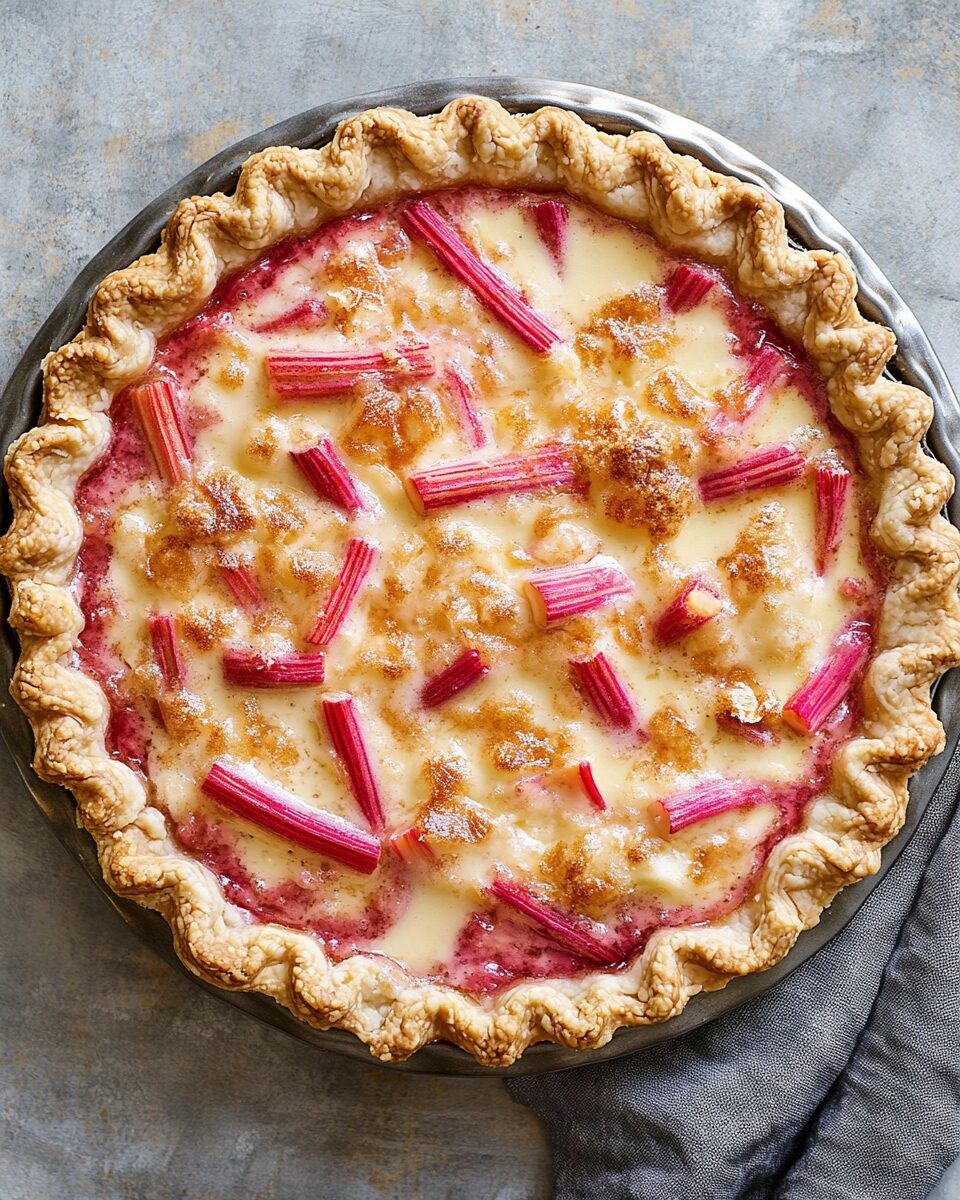The Rhubarb Custard Pie is a celebration of old-fashioned baking and seasonal produce. Tart rhubarb is the star here, nestled into a golden, flaky crust and balanced with a rich vanilla custard that melts in your mouth. The nutmeg adds a gentle warmth, bringing out the unique tang of the rhubarb.
Perfect for spring gatherings, family dinners, or a solo afternoon treat, this pie delivers a beautiful contrast of flavors and textures. It’s one of those timeless recipes that carries both comfort and charm, and might just become a new seasonal favorite in your home.
Full Recipe
Ingredients:
-
1 9-inch unbaked pie crust
-
3 cups chopped fresh rhubarb
-
3 large eggs
-
1 1/2 cups granulated sugar
-
1/4 cup all-purpose flour
-
1/2 teaspoon ground nutmeg
-
1/2 teaspoon vanilla extract
-
1/4 teaspoon salt
-
1 tablespoon unsalted butter
Directions:
-
Preheat your oven to 375°F (190°C).
-
Line a 9-inch pie plate with the unbaked pie crust. Trim and crimp the edges as desired.
-
Spread the chopped rhubarb evenly over the bottom of the pie crust.
-
In a large bowl, whisk together the eggs, sugar, flour, nutmeg, vanilla extract, and salt until smooth.
-
Pour the custard mixture evenly over the rhubarb in the crust.
-
Dot the top of the pie with small pieces of butter.
-
Bake for 50 to 60 minutes, or until the custard is set and the top is lightly golden brown.
-
Allow to cool completely before slicing. Serve chilled or at room temperature.
Prep Time: 15 minutes | Cooking Time: 55 minutes | Total Time: 1 hour 10 minutes
Kcal: 295 kcal | Servings: 8 slices
The History and Appeal of Rhubarb Custard Pie
Rhubarb Custard Pie is a beloved dessert that finds its roots in vintage American baking traditions. Often passed down through generations, this dish reflects a time when seasonal fruits and simple pantry staples were transformed into comforting, flavorful creations. The combination of tart rhubarb and sweet, creamy custard represents a classic culinary harmony—one that continues to captivate taste buds across ages and regions.
The dish became especially popular in rural homes and farming communities where rhubarb grew abundantly in the spring. Known as the “pie plant,” rhubarb has a long-standing reputation for starring in rustic, homespun pies. When coupled with a custard base made of eggs, sugar, and a touch of vanilla or nutmeg, the result is a beautifully balanced dessert that’s both tangy and rich.
Understanding the Flavor Profile
Rhubarb has a distinct tartness, which can be overpowering on its own. However, when it’s blended with a velvety custard, the acidity mellows, allowing for a more rounded, complex flavor. The custard brings a smooth texture and sweet undertone that complements rhubarb’s sharp edge, making every bite both lively and comforting.
The addition of nutmeg or cinnamon (depending on personal or regional preferences) brings a warm spice note that deepens the overall flavor. A buttery, flaky crust acts as the perfect vessel for this flavorful filling, offering a crisp contrast to the soft interior. The texture trifecta—crisp crust, tender rhubarb, and creamy custard—is one of the many reasons this pie remains a staple during rhubarb season.
The Importance of Fresh, Seasonal Ingredients
Rhubarb is best enjoyed during its peak season, typically from April to June in most parts of North America and Europe. Its vibrant pink stalks not only brighten the pie visually but also carry the most flavor when fresh. This dish is a great example of seasonal eating, making the most of spring’s early harvests.
While you can find frozen rhubarb year-round, using fresh rhubarb ensures the best texture and flavor. Many bakers take pride in sourcing their rhubarb locally or even growing it themselves, making this pie feel even more personal and rewarding.
Why This Pie Stands Out Among Other Fruit Pies
Unlike pies that rely solely on fruit and sugar for filling—like apple or cherry pie—rhubarb custard pie brings a more nuanced eating experience. The custard element adds a silky richness that offsets the assertiveness of rhubarb. It’s not overly sweet or overwhelmingly tart; it walks a delicate line that makes it especially satisfying for those who enjoy more complex desserts.
Moreover, the custard filling helps bind the rhubarb together without making the pie soggy, something that can be a challenge when baking with water-rich fruits or vegetables like rhubarb. As a result, the pie slices cleanly, holds its shape, and offers a smooth bite from edge to center.
Serving Suggestions and Variations
Rhubarb Custard Pie is often served chilled, which enhances the smoothness of the custard and sets the pie firmly. A dollop of freshly whipped cream on top or a scoop of vanilla ice cream alongside elevates the dessert further, adding coolness and creaminess to each forkful.
If you’re looking to experiment, you can create subtle variations by incorporating a bit of citrus zest into the custard, or even mixing strawberries with rhubarb for a sweeter, fruitier flavor twist. Some recipes also include a streusel topping for added crunch and a touch of brown sugar richness. However, the traditional version remains a favorite for its simplicity and authenticity.
Tips for Baking the Perfect Rhubarb Custard Pie
Achieving the perfect rhubarb custard pie comes down to a few baking basics. First, make sure your rhubarb is finely chopped and evenly distributed in the crust to ensure consistent texture and baking. Using a pie shield or foil can prevent the crust edges from over-browning while the custard bakes thoroughly.
Secondly, allow the pie to cool completely before slicing. This not only helps the custard set but also enhances the overall flavor profile. Baking the pie ahead of time—say, the night before you plan to serve it—can make it even better, as the custard firms up and the flavors meld beautifully overnight.
Lastly, if you’re making your own crust, be sure it’s well-chilled before baking to avoid shrinkage and maintain flakiness. Whether you use butter, lard, or shortening in your crust, cold ingredients are essential for that perfect bite.
Nutritional Considerations and Moderation
While not a low-calorie dessert, rhubarb custard pie can still fit into a balanced diet when enjoyed in moderation. Rhubarb itself is low in calories and high in fiber and vitamin K. The custard brings protein from eggs and some fat content, depending on how it’s prepared. A standard slice is satisfying and rich enough that you won’t feel the need to go back for seconds—though you might want to.
For those watching their sugar intake, you can slightly reduce the sugar in the custard or use a sugar substitute. Keep in mind, however, that the tartness of rhubarb may require at least a minimal amount of sweetener to be palatable.
Cultural and Nostalgic Significance
This pie is more than a spring dessert—it’s a slice of nostalgia. For many, rhubarb custard pie recalls memories of grandmothers’ kitchens, family reunions, and warm afternoons on the porch. It’s a dessert that feels like home. That kind of emotional connection to food is powerful and one of the reasons these recipes endure.
Rhubarb, once considered a humble garden plant, has risen to cult status among seasonal bakers, and recipes like this ensure its legacy remains strong in home kitchens everywhere. The combination of heritage, taste, and simple beauty makes rhubarb custard pie a treasure.
Conclusion
Rhubarb Custard Pie is a timeless dessert that strikes the perfect balance between sweet and tart, creamy and crisp. Its roots in traditional American baking give it an old-fashioned charm, while its flavor and texture remain irresistibly relevant in today’s kitchens. Whether you’re a seasoned baker or trying rhubarb for the first time, this pie offers a deeply satisfying experience that’s both comforting and refreshingly unique.
Made with seasonal ingredients and simple techniques, it’s a wonderful reminder of the joys of home baking. Serve it at your next gathering, as part of your spring menu, or as a treat for yourself—you’ll be making more than just a dessert; you’ll be making memories.






